
Build in Public SaaS: Guide + 5 Examples

par
Wiktoria Slowikowska
2 oct. 2024
Identifiez et convertissez vos utilisateurs les plus importants
Créer un compte
Building a Software as a Service (SaaS) product in public offers valuable opportunities for developers and businesses. Let’s dive into why this approach is so impactful! This method not only fosters transparency but also encourages community engagement and collaboration.
By sharing the development journey openly, you can gather valuable feedback, build trust, and create a product that truly meets the needs of your users. In this article, we will explore the key aspects of building public SaaS, including its benefits, challenges, and practical steps to succeed.
Understanding the Concept of Building in Public SaaS
Defining Public SaaS
Building in public SaaS means sharing the journey of creating a software product openly with the community. Now, let's talk about why this transparency matters! This approach allows founders and developers to connect with users and gather insights as they build. The idea is to be transparent about the process, challenges, and successes.
Benefits of Building in Public
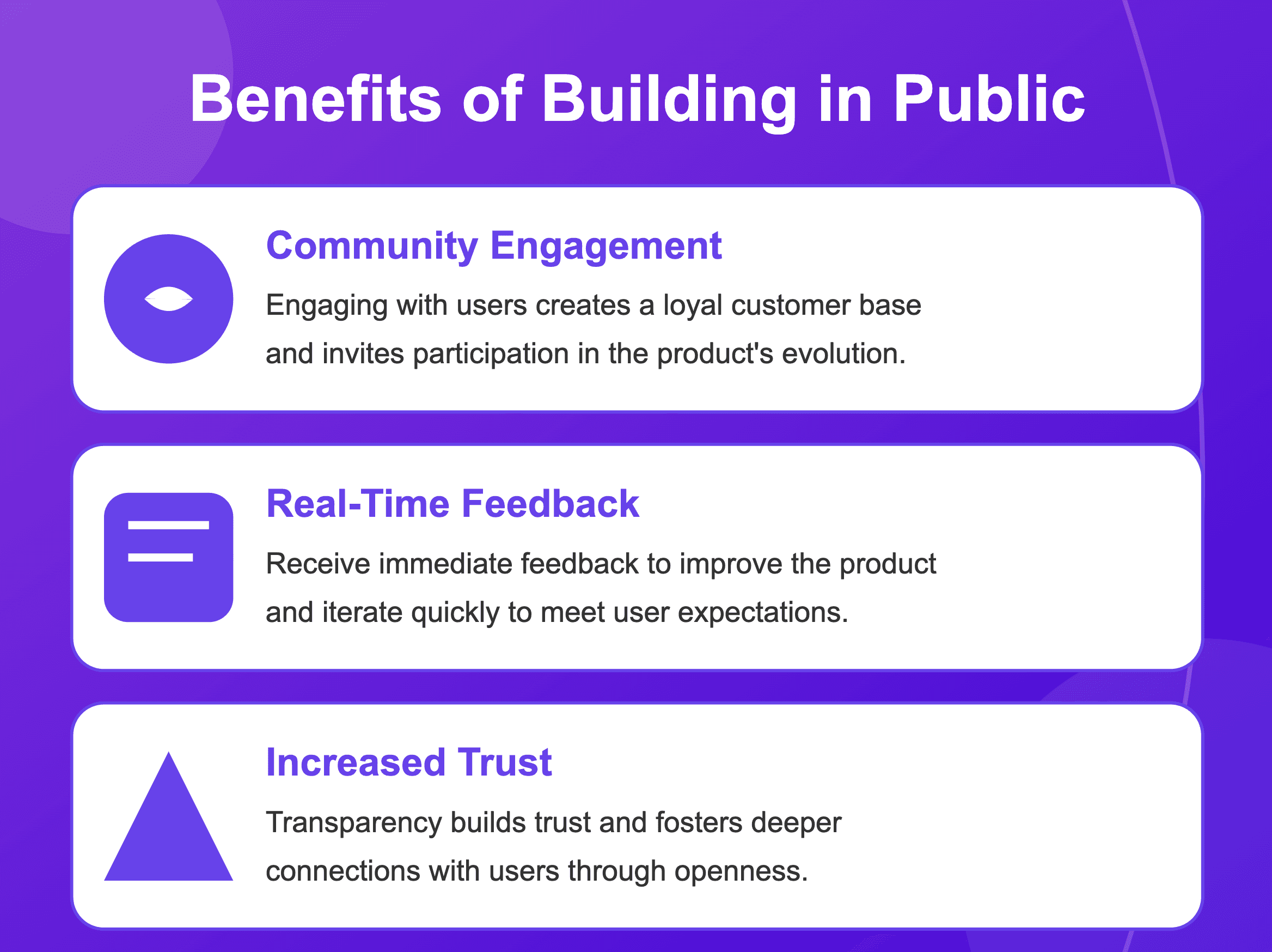
Community Engagement: Engaging with users can create a loyal customer base. Did you know that by sharing your story, you not only attract attention but also invite participation? As highlighted in the transcript, this participation can lead to a more dedicated following, as users feel more involved in the product's evolution.
Real-Time Feedback: You can receive immediate feedback that helps improve the product. Isn’t it amazing how a quick response can lead to significant changes? This feedback loop allows you to iterate quickly and align your features with customer expectations.
Increased Trust: Transparency builds trust with your audience, making them feel involved in the journey. Let’s emphasize this point! As noted in the video, when you show vulnerability and openness, it fosters a deeper connection with your users.
Challenges and Considerations
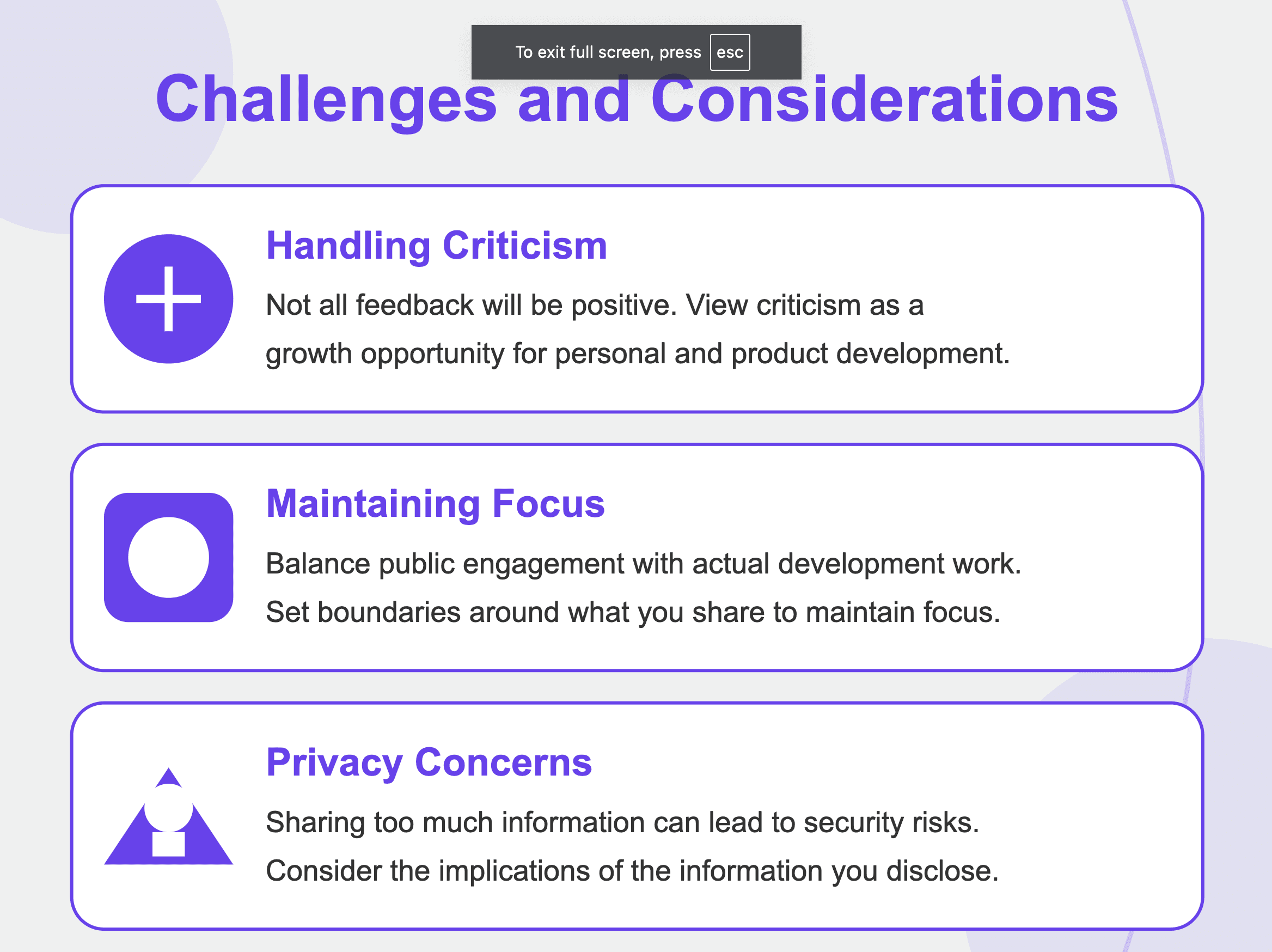
Handling Criticism: Not all feedback will be positive, and it’s essential to manage negative comments constructively. Let’s face it; criticism can be tough! The ability to view criticism as a growth opportunity is crucial for personal and product development.
Maintaining Focus: Balancing public engagement with actual development work can be tricky. Now, how can we manage this? As mentioned in the transcript, setting boundaries around what you share can help maintain this balance.
Privacy Concerns: Sharing too much information can lead to security risks or misunderstandings. This is an important consideration! Always consider the potential implications of the information you disclose.
Building in public is not just about sharing successes; it’s also about being open about failures and learning from them.
Building in Public
Engaging with Your Audience
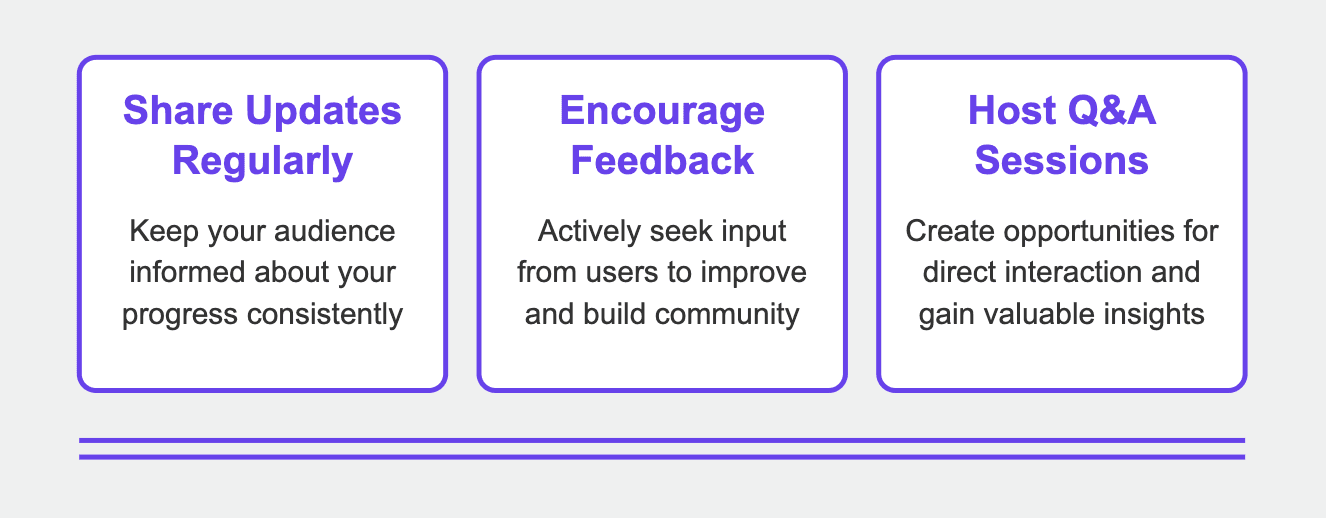
Engagement is key in building in public. Now, let’s explore some effective strategies!
Share Updates Regularly: Keep your audience informed about your progress by posting consistent updates. Did you know? Regular communication builds anticipation and maintains interest in your project.
Encourage Feedback: Actively seek input from your users by asking for their thoughts and suggestions. This not only improves your product but also fosters a sense of community and involvement among your audience.
Host Q&A Sessions: Create opportunities for direct interaction with your audience through Q&A sessions. Let’s highlight this! These sessions can provide valuable insights into user needs and preferences while enhancing engagement and connection.
This involves consistently sharing the progress of your SaaS business on social media. Are you ready for this? The host emphasizes the importance of consistency, likening it to the regularity needed to see results from gym workouts. You should aim to post daily, regardless of how imperfect your content may feel initially.
Platforms to Use
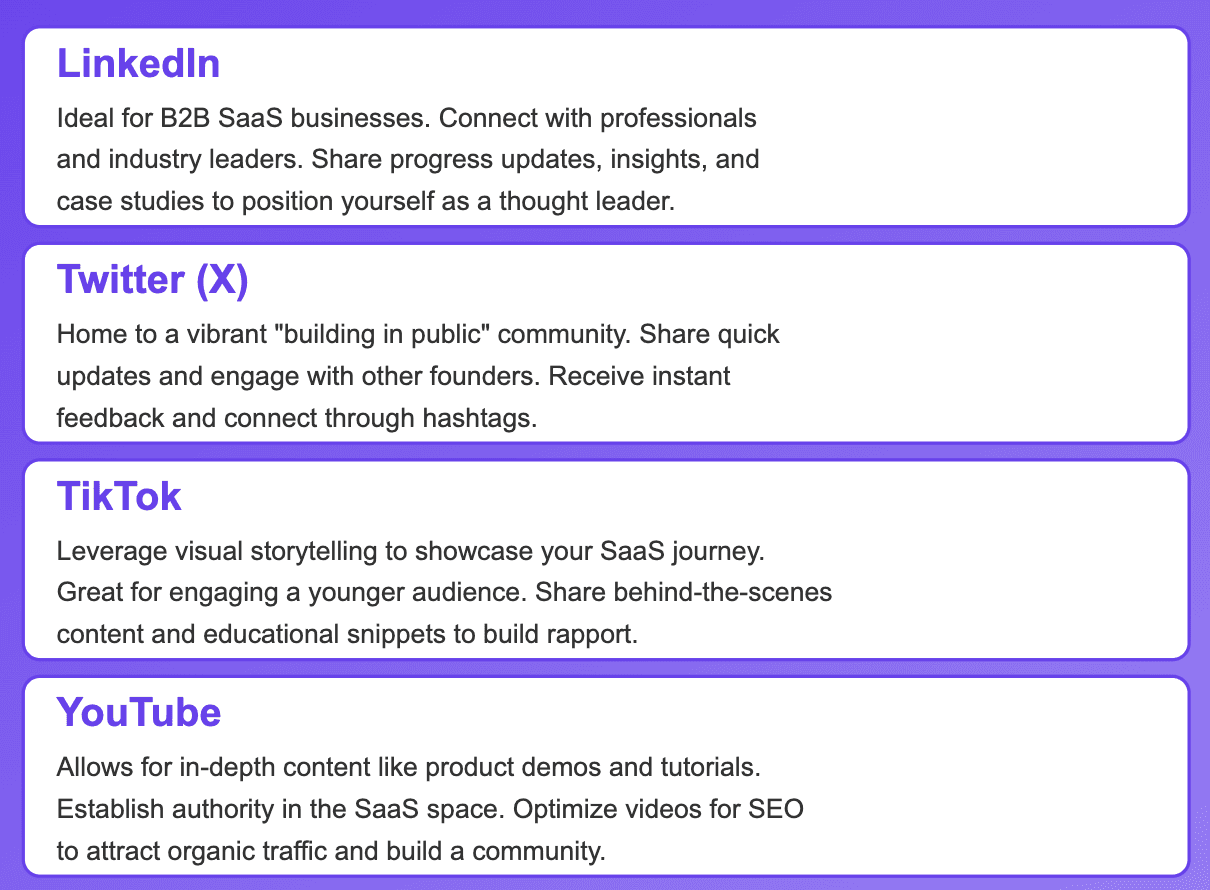
Depending on your target audience, different platforms may be effective:
LinkedIn
LinkedIn is ideal for B2B SaaS businesses, allowing you to connect with professionals and industry leaders. Now, let’s see how you can leverage this platform! By sharing progress updates, insights, and case studies, you can position yourself as a thought leader while engaging with potential clients. Its networking capabilities facilitate valuable relationships that can drive growth.Twitter (X)
Twitter is home to a vibrant "building in public" community, perfect for sharing quick updates and engaging with other founders. Let’s explore the benefits of this platform! The platform's real-time nature allows you to receive instant feedback and connect with potential customers through hashtags. Regular interactions can help build a loyal following and foster meaningful connections.TikTok
TikTok leverages visual storytelling to showcase your SaaS journey creatively, making it great for engaging a younger audience. Have you considered this approach? You can share behind-the-scenes content and educational snippets to build rapport with viewers. The platform's viral potential can significantly increase your brand's visibility and attract new users.YouTube
YouTube allows for in-depth content, such as detailed product demos and tutorials, helping establish your authority in the SaaS space. Let’s talk about how to maximize this platform! By optimizing your videos for SEO, you can attract organic traffic and build a community through viewer engagement. It’s an effective platform for storytelling and sharing comprehensive updates on your progress.
Document Your Journey
Share everything—your successes, failures, and day-to-day processes. Now, this is crucial! The host emphasizes that early posts may not be perfect, but consistency will improve your content over time and help you understand each platform’s algorithm. Examples from the host’s personal experiences on TikTok highlight that while early efforts were not successful, they eventually led to better content and engagement.
Why It Works
Building in public holds you accountable to yourself and your audience. This is a powerful motivator! The community will support and cheer you on, encouraging you to stay committed. Plus, potential customers get to know, like, and trust you, making them more likely to buy.
Remember, building in public is not just about transparency; it’s about creating a community around your product. Engagement fosters loyalty and trust.
Real-Time Customer Feedback in Public SaaS
Importance of Customer Feedback
Real-time customer feedback is crucial for any SaaS business. Let’s delve into why this matters. It allows you to understand your users' needs as they interact with your product. This quick-response system lets you capture customer feedback as they navigate your platform, creating a direct line to their thoughts and experiences. As the video notes, feedback can also guide your future product direction, ensuring you stay aligned with market demands.
Incorporating Feedback into Development
Once you have collected feedback, it’s essential to incorporate it into your development process. How can you do this effectively? Here are some steps to follow:
Analyze the Feedback: Review feedback to identify common themes and prioritize issues based on their impact on user experience. This helps guide your development priorities effectively.
Communicate Changes: Inform customers about changes made as a result of their feedback, demonstrating that their opinions are valued. This transparency fosters trust and strengthens your relationship with users.
Iterate Continuously: Keep an open feedback loop by encouraging ongoing input from users after implementing changes. Let’s emphasize this commitment! This commitment to continuous improvement ensures your product evolves to meet customer needs.
Engaging with your customers through real-time feedback not only enhances your product but also builds trust and loyalty. By listening to their needs, you can create a product that truly resonates with your audience.
Creating a Public Product Roadmap
What is a Public Product Roadmap?
A public product roadmap is a strategic document that outlines your product’s development plan, highlighting upcoming features, improvements, and long-term goals. Now, let’s see why this is essential! It serves as a transparent communication tool that provides stakeholders, including customers, team members, and potential investors, with a clear understanding of where your product is headed.
Overcoming Common Challenges
Building a SaaS product in public can be exciting, but it also comes with its own set of challenges. Are you ready to tackle these hurdles? Here are some common challenges and how to address them effectively.
Handling Negative Feedback
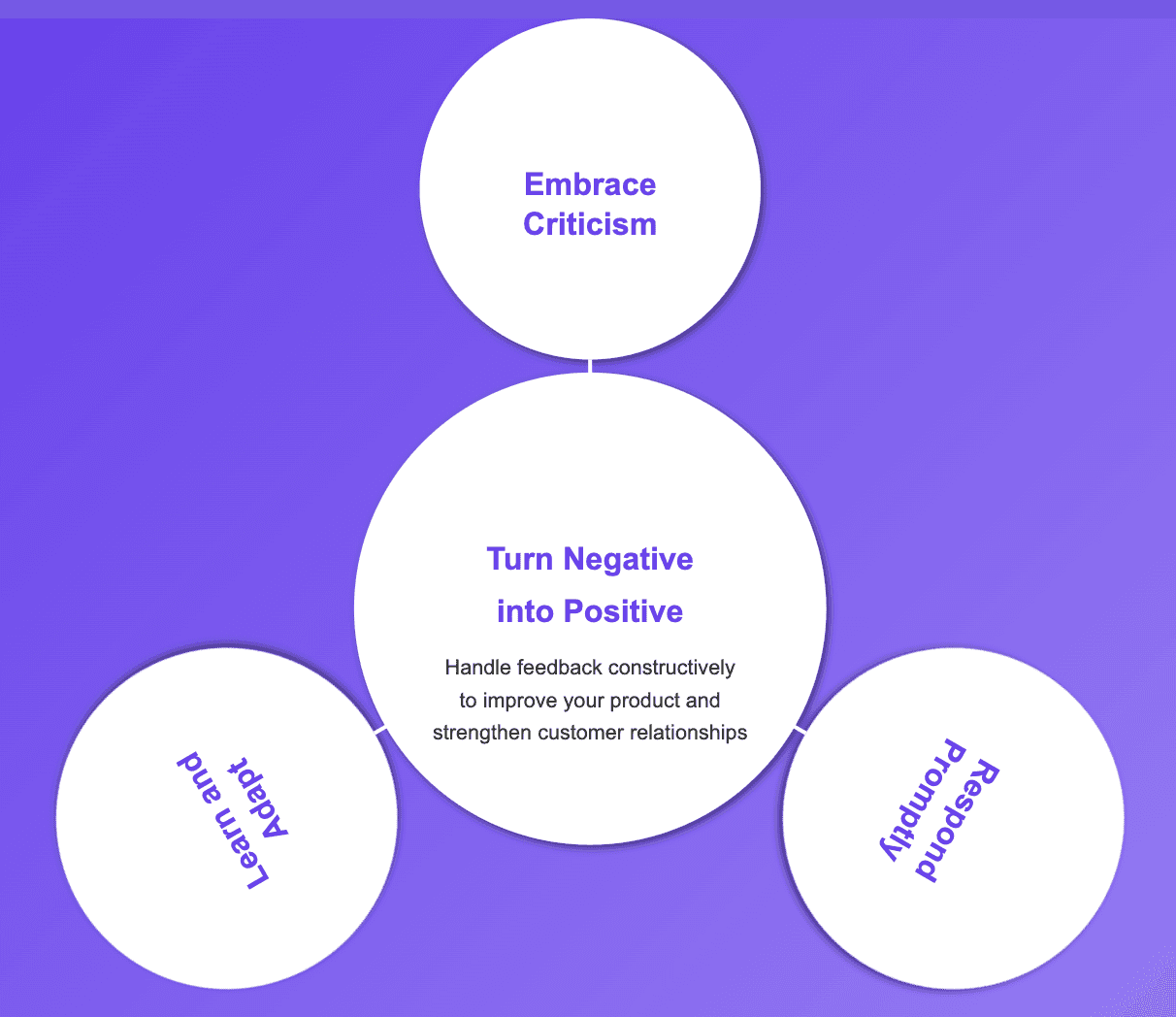
Embrace Criticism: While negative feedback can be challenging to hear, it presents an opportunity for growth and improvement. Let’s view this positively! View it as a valuable insight into your product and a chance to enhance the user experience.
Respond Promptly: Addressing concerns quickly shows your audience that you value their input and care about their experience. Why is this important? Timely responses can help diffuse potential issues and demonstrate your commitment to customer satisfaction.
Learn and Adapt: Use the feedback you receive to make necessary changes to your product. This is key! By actively implementing suggestions and demonstrating that you listen to your users, you can foster loyalty and trust within your community.
Maintaining Transparency

Share Your Journey: Regularly update your audience on your progress, including both successes and setbacks. Did you know? This openness fosters a sense of community and keeps users engaged in your journey.
Be Honest About Challenges: Don’t shy away from discussing difficulties you encounter. This is crucial! Being transparent about challenges builds trust with your users and demonstrates authenticity in your development process.
Regular Updates: Consistently communicate your plans and any changes to your product roadmap. Let’s keep everyone in the loop! Keeping your audience informed helps ensure everyone stays in the loop and reinforces your commitment to transparency.
Balancing Public and Private Development
Set Boundaries: Establish clear guidelines for what information can be shared publicly and what should remain private. This is vital for security! This helps protect sensitive data and proprietary strategies while allowing for transparency in your communications.
Use Private Channels: For sensitive discussions, utilize private forums, direct messages, or encrypted platforms. This ensures confidentiality! This ensures that confidential topics, like strategic decisions or financial matters, are discussed securely without the risk of public scrutiny.
Plan Your Releases: Schedule public updates to align with significant milestones in your development, such as product launches or feature releases. Let’s create excitement! This approach creates excitement and maintains user engagement while highlighting the impact of user feedback.
Real-World Examples: Build in Public Posts
Strategic Pricing Transparency

This tweet from Marc Lou (@marc_louvion) exemplifies the build-in-public approach for his product, @HabitsGarden. Marc shares his pricing strategy experiment, offering a $5/month plan and a $47 lifetime deal. The lifetime option, priced at less than 10 months of the monthly subscription, likely aims to increase perceived value and encourage long-term commitments. This could rapidly grow his user base and secure upfront revenue, though it might reduce long-term revenue per loyal user.
By openly discussing this experiment, Marc demonstrates key aspects of building in public: transparency, real-time updates, and community engagement. The tweet showcases how entrepreneurs can use social media to share their product development journey, test ideas, and connect with their audience, embodying the build-in-public methodology.
Demystifying Marketing
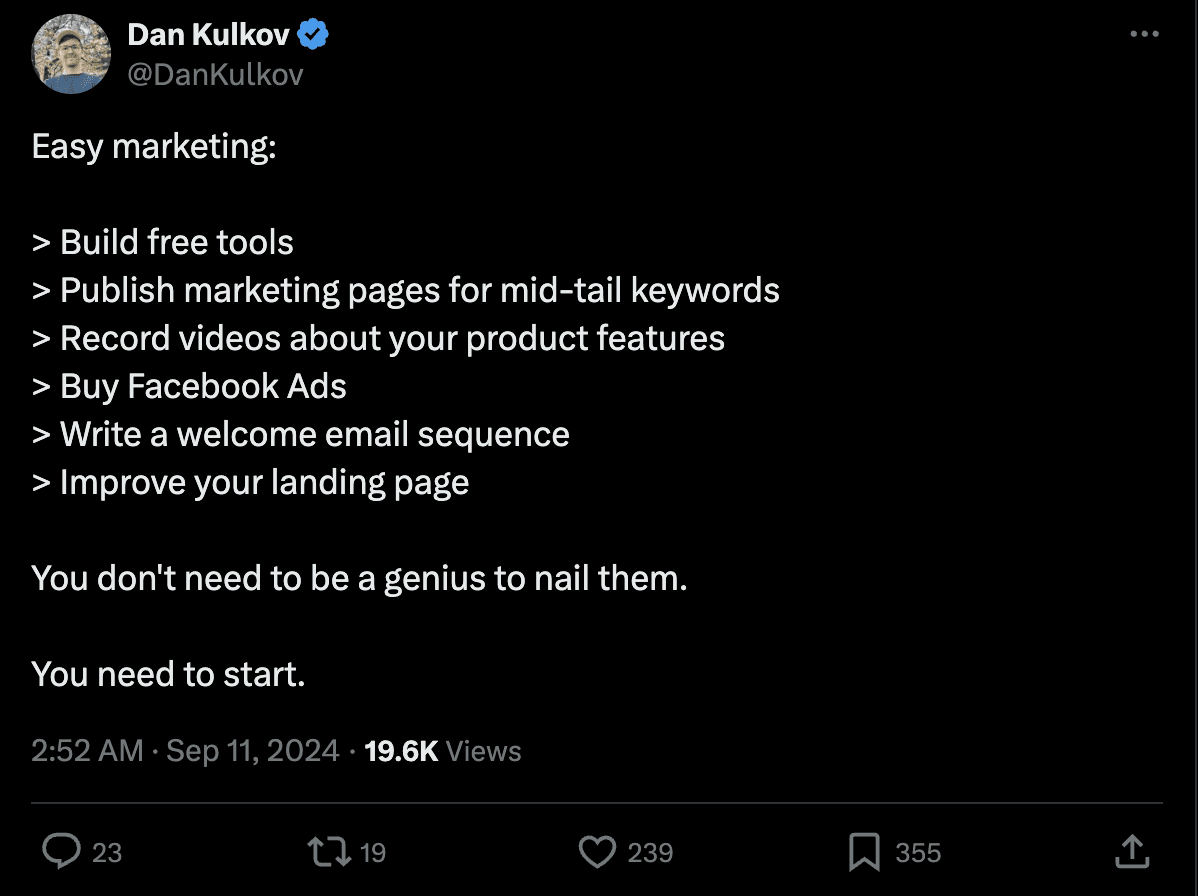
This tweet from Dan Kulkov (@DanKulkov) offers a concise, actionable list of marketing strategies for entrepreneurs. Dan outlines six straightforward tactics, ranging from building free tools to improving landing pages. The advice is framed as "Easy marketing," making it approachable for beginners.
What stands out is Dan's emphasis on starting rather than perfection. His closing statements, "You don't need to be a genius to nail them. You need to start," encapsulate a core principle of the build-in-public movement - taking action and learning through doing.
By sharing these tips openly, Dan provides value to his audience while potentially sparking discussions or questions that could further enrich the community's knowledge. This tweet exemplifies how sharing practical insights can be an effective way to engage and grow an audience while building in public.
A Build-in-Public Roadmap

This LinkedIn post by Olly Meakings exemplifies the build-in-public approach for SaaS companies. Olly shares his strategic focus for his product Senja, shifting away from new marketing efforts to improving the customer lifecycle.
Olly's transparency extends to sharing his ultimate goal of achieving net negative churn, while acknowledging this won't happen quickly.
The post includes a detailed chart of planned tests and changes for each stage of the customer lifecycle in Q4 2024. This level of openness about future plans and current challenges is a hallmark of the build-in-public methodology.
By sharing this roadmap, Olly invites his audience into the product development process, potentially gathering feedback and building trust with current and prospective customers. This approach demonstrates how SaaS founders can leverage social media to share their journey, strategic thinking, and invite community engagement.
Celebrating Growth While Confronting Challenges
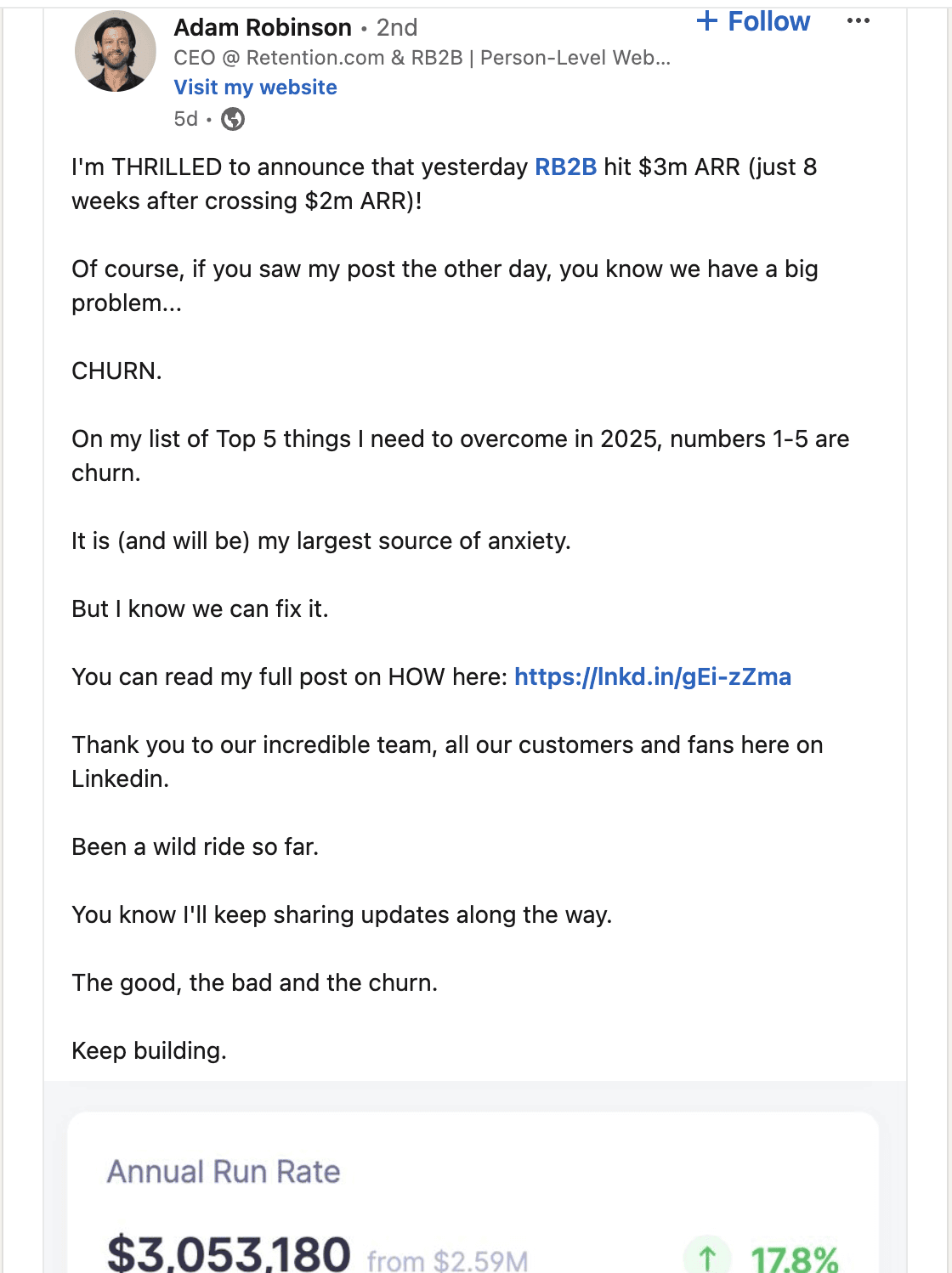
This LinkedIn post by Adam Robinson, CEO of RB2B, exemplifies the build-in-public approach through its mix of celebration and candid problem-sharing. Adam announces a significant milestone - hitting $3m ARR just 8 weeks after reaching $2m ARR. However, he immediately follows this with transparency about a major challenge: churn.
Adam's openness about listing churn as his top 5 priorities for 2025 and describing it as his "largest source of anxiety" demonstrates vulnerability rarely seen in traditional corporate communication. This honesty likely resonates with other entrepreneurs facing similar challenges.
The post balances optimism ("But I know we can fix it") with realism, and Adam commits to continuing to share updates "The good, the bad and the churn." This ongoing narrative invites his audience to follow the company's journey, potentially building a more engaged community around his product.
By sharing both successes and struggles, Adam humanizes his role as a CEO and makes the entrepreneurial journey more relatable. This approach can foster trust and connection with customers, potential clients, and the wider business community.
A Founder's Journey Map

This LinkedIn post by Guillaume Moubeche, founder of lemlist, offers a comprehensive overview of the key milestones in a bootstrapped SaaS company's growth journey. Guillaume shares his experience of growing lemlist to $26M ARR and distills it into a relatable timeline for other founders.
What makes this post exemplary of the build-in-public approach is its blend of achievements and challenges. Guillaume doesn't shy away from mentioning difficult moments like getting rejected by VCs, encountering the first bug, or having to fire someone. This honesty creates a more authentic picture of entrepreneurship.
The post covers a wide range of milestones, from early-stage hurdles (first rejection, first MVP) to later-stage realizations (understanding the S-curve of growth, the importance of investing in employees). This comprehensive view provides value to founders at various stages of their journey.
By sharing these insights, Guillaume invites engagement from his audience, as evidenced by the interaction metrics. The closing questions encourage further discussion, embodying the community-building aspect of the build-in-public methodology.
This post demonstrates how experienced founders can contribute to the entrepreneurial ecosystem by openly sharing their journey, including both triumphs and tribulations.
These examples demonstrate the versatility and power of the build-in-public approach across different platforms and stages of business growth. From Marc Lou's transparent pricing experiments on Twitter to Adam Robinson's candid discussion of challenges on LinkedIn, each post offers a unique window into the entrepreneurial journey.
Key takeaways from these examples include:
Transparency breeds trust and engagement
Sharing both successes and challenges creates authenticity
Real-time updates on strategy and experiments invite community participation
Detailed insights and personal experiences provide value to fellow entrepreneurs
The build-in-public approach spans various aspects of business, from pricing to growth strategies
By openly sharing their experiences, these founders not only build their personal brands but also contribute to a collective knowledge base for the startup community. This approach turns social media into a powerful tool for learning, collaboration, and growth in the entrepreneurial ecosystem..
Conclusion
Creating a public product roadmap is essential for any SaaS company. Let’s reflect on the benefits! It not only helps in building trust with users but also encourages feedback and collaboration. By keeping your roadmap updated, you can ensure that your audience stays informed and engaged with your product's journey.




